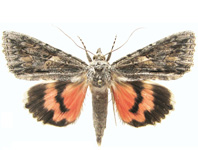Abstract
Sand flies are insects of medical and veterinary importance, because some species are able to transmit several pathogens such as Bartonella spp., Phlebovirus spp., and protozoan parasites of the genus Leishmania (Ross). They are widely distributed in the Americas, with recordings ranging from Canada to Argentina. Approximately 500 Phlebotominae species are known in the Americas, of which it is considered that at least 56 are involved in the transmission of leishmaniasis (Maroli et al. 2012). Previous studies have shown that the phlebotomine fauna in Argentina consists of 32 species distributed in 14 provinces (Quintana et al. 2012; Sábio et al. 2015; Salomón et al. 2010). Of these species, Lutzomyia longipalpis (Lutz & Neiva), Nyssomyia neivai (Pinto), Ny. whitmani (Antunes & Countinho), Cortelezzii complex [Evandromyia cortelezzii (Brèthes) – Ev. sallesi (Galvão & Coutinho)], Micropygomyia quinquefer (Dyar) and Migonemyia migonei (França) have been found with DNA of Leishmania spp. (Moya et al. 2015). Five new records of species in the province of Chaco, obtained from different projects carried out between 2001 and 2015, four of which are also new records for Argentina, are described in this article. Their importance as potential vectors and the correct determination of the sympatric species is also discussed.
References
Aguiar, G.M. & Medeiros, W.M. (2003) Distribuição regional e hábitats das espécies de flebotomíneos do Brasil. In: Rangel, E.F. & Lainson, R. (Eds.), Flebotomíneos do Brasil. Fiocruz, Rio de Janeiro, pp. 207–255.
Carvalho, G.M., Brazil, R.P., Sanguinette, C.C. & Andrade Filho, J.D. (2011) Description of Evandromyia spelunca, a new phlebotomine species of the cortelezzii complex, from a cave in Minas Gerais State, Brazil (Diptera: Psychodidae: Phlebotominae). Parasites & Vectors, 4, 158.
http://dx.doi.org/10.1186/1756-3305-4-158Carvalho, G.M.L., Filho, J.D.A., Falcão, A.L., Rocha Lima, A.C.V.M. & Gontijo, C.M.F. (2008) Naturally infected Lutzomyia sand flies in a Leishmania endemic area of Brazil. Vector-Borne and Zoonotic Diseases, 8, 407–414.
http://dx.doi.org/10.1089/vbz.2007.0180Forattini, O.P. (1973) Entomologia médica. Psychodidae, Phlebotominae, Leishmanioses, Bartonelose. Edgard Blücher Ltda., São Paulo, 658 pp.
Galati, E.A.B. (2003) Morfologia, terminologia de adultos e identificação dos táxons da América. In: Rangel, E.F. & Lainson, R. (Eds.), Flebotomíneos do Brasil. Fiocruz, Rio de Janeiro, pp. 53–175.
Galati, E.A.B. (2015) Phlebotominae (Diptera, Psychodidae) Classificação, morfologia, terminologia e identificação de Adultos. Apostila: Bioecologia e Identificação de Phlebotominae 2015, I, 1–127. Available from: http://www.fsp.usp.br/egalati/ (accessed 16 July 2015)
Maroli, M., Feliciangeli, M.D., Bichuad, L., Charrel, R.N. & Grandoni, L. (2012) Phlebotomine sandflies and the spreading of leishmaniases and other diseases of public health concern. Medical and Veterinary Entomology, 27, 123–147.
http://dx.doi.org/10.1111/j.1365-2915.2012.01034.xMorrone, J. (2001) Biogeografía de América Latina y el Caribe. M &T - Manuales y Tesis SEA 3, Zaragosa, 148 pp.
Moya, S.M., Giuliani, M.G., Manteca Acosta, M., Salomón, O.D. & Liotta, D.J. (2015) First description of Migonemyia migonei (França) and Nyssomyia whitmani (Antunes & Coutinho) (Psychodidae: Phlebotominae) natural infected by Leishmania infantum in Argentina. Acta Tropica, 152, 181–184.
http://dx.doi.org/10.1016/j.actatropica.2015.09.015Muzón, J., Spinelli, G.R., Salomón, O.D. & Rossi, G.C. (2002) A first record of phlebotominae from Argentinean Patagonia (Diptera: Psychodidae: Phlebotominae). Memorias do Instituto Oswaldo Cruz, 97, 797–798.
http://dx.doi.org/10.1590/S0074-02762002000600008Quintana, M.G., Fernández, M.S. & Salomón, O.D. (2012) Distribution and abundance of Phlebotominae, vectors of Leishmaniasis, in Argentina: spatial and temporal analysis at different scales. Journal of Tropical Medicine, 2012, 1–16.
http://dx.doi.org/10.1155/2012/652803Rosa, J., Pereira, D.P., Brazil, R.P., Filho, J.D.A., Salomón, O. & Szelag, E. (2012) Natural infection of cortelezzii complex (Diptera: Psychodidae: Phlebotominae) with Leishmania braziliensis in Chaco, Argentina. Acta Tropica, 123, 128–131.
http://dx.doi.org/10.1016/j.actatropica.2012.04.008
Rosa, J.R., Salomon, O.D., Andrade Filho, J.D., Carvalho, G.M.L., Szelag, E.A., Stein, M., Tapia, E.S. & Brazil, R.P. (2010) Phlebotomine sand flies (Diptera: Psychodidae) of the province of Chaco, Argentina. Neotropical Entomology, 39, 303–305.
http://dx.doi.org/10.1590/s1519-566x2010000200024Sábio, P.B., Andrade, A.J. & Galati, E.A.B. (2014) Assessment of the taxonomic status of some species included in the Shannoni complex, with the description of a new species of Psathyromyia (Diptera: Psychodidae: Phlebotominae). Journal of Medical Entomology, 51, 331–341.
http://dx.doi.org/ 10.1603/me13153Sábio, P.B., Andrade, A.J. & Galati, E.A.B. (2015) Description of Psathyromyia ( Psathyromyia ) baratai sp. n. (Diptera: Psychodidae: Phlebotominae) from Cantareira State Park, São Paulo, Brazil. Journal of Medical Entomology, 1–8. [published online]
http://dx.doi.org/ 10.1093/jme/tjv173Salomón, O.D., Filho, J.D.A., Fernández, M.S., Rosa, J.R., Szelag, E.A. & Santini, M.S. (2010) Nuevos registros de Phlebotominae (Diptera: Psychodidae) para la Argentina. Revista de la Sociedad Entomológica Argentina, 69, 261–265.
Saraiva, L., Filho, J.D. a, de Oliveira Silva, S., de Andrade, a. S.R. & Melo, M.N. (2010) The molecular detection of different Leishmania species within sand flies from a cutaneous and visceral leishmaniasis sympatric area in Southeastern Brazil. Memorias do Instituto Oswaldo Cruz, 105, 1033–1039.
http://dx.doi.org/10.1590/s0074-02762010000800013Spinelli, G.R., Rossi, G.C. & Rodríguez, E.A. (1999) Further notes on Phlebotominae from Argentina (Diptera: Psychodidae). Revista de la Sociedad Entomológica Argentina, 58, 197–200.
Sudia, W.D. & Chamberlain, R.W. (1962) Battery-operated light trap, an improved model. Mosquito News, 22, 126–129.

